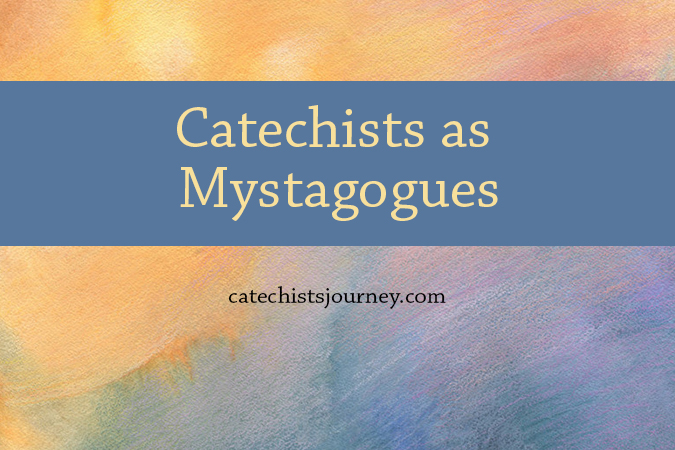
In his research about why some things go viral on social media, author Jonah Berger discovered that one of the main reasons is that the item provokes emotion, whether good or bad. Emotions play a key role in decisions that people make in all areas of their lives. Aware of this reality, marketers often tap into emotions in their advertising.
One of the reasons that our faith formation efforts are struggling is because they too often ignore emotion and remain at the cerebral or intellectual level where the soil is too often compacted by ideas, beliefs, and ideologies that have deep roots and leave little room for future growth. As mystagogues, we catechists do more than indoctrinate. If faith formation were simply an intellectual exercise, we could simply provide every participant with a copy of the Catechism of the Catholic Church, have them read and study it, and then give an exam. That’s not how disciples are made, however. As mystagogues, we accompany people as they embark on a new way of being human, tilling the soil of their hearts and opening them up to a relationship with Jesus Christ.
In his book, What Do You Really Want? St. Ignatius Loyola and the Art of Discernment, Jim Manney writes, “Psychologists talk about the three parts of the mind: the cognitive (reason and other mental processes), the conative (the will), and the affective (feelings and emotions). All of these are involved in the choices we make, but the engine that drives the train is the affective power. The traditional word for it is heart.” Here are some of the ways that the mystagogical catechist touches people’s hearts.
- Tell (and invite) personal stories. We can help others to know that something is important, but it is much more effective to help others feel that something is important. Storytelling can do just that. It is most effective to share stories that illustrate how faith in Jesus Christ has changed you and helped you to grow.
- Use video. Not all stories need to be yours. You can find and utilize numerous video clips from a variety of sources, including YouTube, that tell stories that provoke emotion. For example, I like to use this video to talk about how, through Baptism, we become adopted children of God.
- Make eye contact. Direct eye contact communicates that someone finds us fascinating, engaging, or appealing. It communicates recognition and connection. Direct eye contact increases people’s rate of retention. Use it to your advantage to make connections with those you teach.
- Incorporate you-focused language. An effective way to make an emotional connection with those you’re speaking to is to incorporate “you-focused” language in your delivery—language that makes it clear that you are speaking directly to someone. While it’s good to share personal stories, it is important to not make it all about you. Tap into the experiences of those you teach.
- Use names. According to a study from the Institute for the Study of Child Development, hearing one’s own name significantly impacts the brain. Since a name is a person’s greatest connection to his or her identity, when you use a name, you show that you really know a person and are speaking directly to him or her. It shows that you are truly devoting attention to the person.
- Make cultural or ethnic connections. A key part of people’s core identity is their ethnicity or cultural background. If you want to make an emotional connection with those you teach, be sure to make connections to their ethnicity. If we hope to make emotional connections with those we teach, we need to be sure that all people can recognize themselves in the Gospel we are proclaiming.
- Make connections to pop culture. A good way to get people talking is to get them talking about something that they are already talking about! Jesus was masterful at this as he tapped into images that were “top of mind” for the crowds he spoke to: fishing, shepherding, tax collecting, cooking, farming, and so on.
- Connect people with one another. The emotional connections do not all have to involve you. In fact, blessed are the catechists who can create emotional connections among participants. While this cannot be forced, it can be encouraged and nurtured. Icebreakers, mentoring relationships, pairings, buddy systems, small groups, pen pals, and cooperative learning activities can go a long way to breaking down barriers and fostering emotional connections for people of all ages.
- Incorporate music and singing. Few things touch the heart like music and singing. While words alone can be powerful, they cannot provoke the same kind of emotion that music does. In her article, “Music Is What Feelings Sound Like” (Psychology Today, 10/23/14), educator and author Cortney S. Warren, Ph.D., claims that “music is a powerful vehicle for helping you become more aware and honest with yourself.”
- Apprentice learners in works of mercy that involve direct contact with others. When possible, works of mercy should bring people into contact with other people with an opportunity to engage them. Many people who are in need feel isolated, and their self-value has been damaged. While it is good to offer material goods to someone in need, it is equally important to engage people with a smile and some words of greeting, acknowledgment, kindness, concern, and simple conversation. Quite often, through such encounters, we come to recognize that those in need have much to teach us.
- Create a sense of the sacred and profound by incorporating sacramentality. For Catholics, our emotions are touched through sacramentality. Signs, symbols, rituals, movements, gestures, silence, singing—all of these can provoke emotion in ways that words alone cannot. While the primary language of the brain is words, the primary language of the heart is symbols. Our Catholic sacramental sensibility recognizes that the most profound moments in life transcend words. We need a language of mystery if we hope to touch people’s hearts.
- Engage learners in meaningful experiences of prayer. When we speak to our closest friends, we typically share our emotions. Prayer should be no different. Too often, prayer is approached as a sterile, intellectual acknowledgment of God’s greatness followed by some timid pleas for help. The bottom line is that when we pray, we should tell God how we feel and pay attention to the feelings God leads us to experience.
In the Spiritual Exercises, St. Ignatius of Loyola teaches us to pray with our feelings and insists that engaging with our emotions is a prerequisite to healthy discernment, since our emotions are a gauge of our spiritual wellbeing. In fact, most of the ways that Ignatius taught people to pray involved emotions. His premise was that understanding was good, but feeling is better. As mystagogues, we can help those we teach to develop a passionate, heartfelt relationship with God.
(This post draws from my book, Preparing Hearts and Minds: 9 Simple Ways for Catechists to Cultivate a Living Faith.)



Be the first to comment